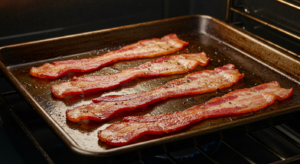
The Importance of Preheating Your Oven
When your recipe calls for a specific temperature, it’s critically important to preheat. This step ensures that your food will cook evenly and at the correct rate. It might be tempting to skip this step, especially when you’re in a rush, but skipping the preheat can result in unevenly cooked meals, or even potential food safety issues. Regardless of whether your oven runs on gas or electricity, proper preheating is essential for great cooking results.
Oven doors play a significant role in preheating, since opening the door prematurely can allow heat to escape, leading to irregular temperatures. You might believe that your oven is ready because the light indicates so, but sometimes ovens give false readings. Using an oven thermometer can help you ensure that you’ve actually reached the correct preheat temperature.
Electric Ovens Vs Gas Ovens
The type of oven you use might affect how long it takes to preheat. Commonly, electric ovens take a little longer to preheat compared to their gas counterparts. An electric oven usually requires approximately 15 to 20 minutes to reach the desired temperature. On the other hand, a gas oven generally preheats faster and can reach the desired temperature in about 10 minutes.
In addition to the time it takes to preheat the oven, the oven temperature you set will also influence the preheat time. Higher temperatures, of course, take longer to reach.

Understanding Preheat Times
On average, most modern ovens take about 15 to 20 minutes to preheat to the desired temperature. However, if your recipe approximates a preheat time of 30 minutes, it might be because the oven needs more time to achieve a higher set temperature. It’s also important to note that older ovens may take longer.
When preheating, it’s smart to start your oven before starting to prepare your dish. That way, the oven will be ready when you’re finished prepping, ensuring your cook time is not impacted by waiting for your oven to reach the right temperature.

Ovens Heat Up Differently
Not all ovens heat up in the same way. For instance, some ovens use the broil and bake elements simultaneously during preheating to speed the process, while others only use the bake element. This difference can influence how long it takes your oven to preheat.
Convection ovens, which circulate hot air with a fan, preheat faster than conventional ovens. It’s good to remember that the location and size of your oven may factor into the time it takes to reach the desired temperature.

Knowing When Your Oven is Ready
The most reliable way to know if your oven has reached the right temperature is by using an oven thermometer. While digital ovens emit a beeping sound once they’re preheated, sometimes ovens give false readings, which is why a thermometer can be handy.
Maintaining your oven well, and replacing the seal if needed, can ensure that heat isn’t escaping from the oven doors while preheating. Preserving heat within the oven will help to achieve the temperature faster.

Adjusting Bake Time
Your bake time may need adjusting if you’ve put your dish in before the oven is fully preheated. Every ingredient reacts differently to heat. For instance, baked goods might turn out denser than usual, while meat could potentially be undercooked. By always preheating your oven before the food goes in, you’ll be ensuring both the safety and the quality of your meals.
If you find that your oven takes longer than expected to preheat, it’s a good idea to have it checked. A faulty part or element might be the reason for the sluggish preheat time.

To Preheat Or Not To Preheat?
There’s been a debate on whether certain types of food need an oven to be preheated or not. However, for most home cooking and baking, it’s typically better to preheat. Skipping the preheat can significantly change the taste and structure of your food.
Nevertheless, for some long, slow cooking dishes, preheating may not be necessary. Yet, when the recipe calls for a preheated oven, it’s best to follow the instructions for the perfect result.

Preheat Tips for a Gas Oven
A gas oven may preheat faster than an electric one, but it might also have hot and cold spots, depending on the flame arrangement. It’s good to turn your baking sheet halfway through the cook time for even cooking.
Allowing the oven to preheat past the desired temperature and then letting it cool down to the needed temperature can also ensure even heating in a gas oven.
How long does it take for an electric oven to preheat?
An electric oven usually takes about 15 to 20 minutes to preheat to the desired temperature.
Is it important to preheat the oven?
Yes, preheating the oven is critical as it ensures that your food will cook evenly and at the correct rate.
Can I skip the preheat step when cooking?
In general, it’s not advisable to skip the preheat step, as it can lead to uneven cooking and potential safety concerns.
Does opening the oven doors while preheating affect the temperature?
Yes, opening the oven doors prematurely during preheating can allow heat to escape and cause irregular temperatures.
Does a gas oven preheat faster than an electric oven?
Yes, a gas oven generally preheats faster than an electric oven and can reach the desired temperature in approximately 10 minutes.
How does preheating the oven affect the cook time?
Preheating the oven ensures that your food starts cooking at the correct temperature right away, affecting the overall cook time given in the recipe.
Why is my oven taking longer to preheat?
If your oven takes longer than usual to preheat, it might be due to a faulty part or element in the oven.
What temperature should the oven reach while preheating?
The oven should reach the temperature appointed in the recipe during preheating.
Does the bake time adjust if the oven is not preheated?
Yes, putting your dish in before the oven is fully preheated can potentially require an adjustment of the bake time.
How can an oven thermometer help during preheating?
An oven thermometer can help you confirm that your oven has reached the correct preheat temperature, especially if your oven sometimes gives false readings.








